It looks like you're using an Ad Blocker.
Please white-list or disable AboveTopSecret.com in your ad-blocking tool.
Thank you.
Some features of ATS will be disabled while you continue to use an ad-blocker.
7
share:
I have done a series of threads on the sites around Gobelki Tepe. GT is the one that gets most of the attention from the mainstream, alternative and
fringe but the other sites give us a better understanding of what was happening in this region, at this critical point when man went from gathering
and hunting to agricultural and herding.
The earlier threads take you from prior to the agricultural 'revolution', at its cusp and its results
Djade
Nevali Cori
Cayonu
Jerf el Ahmar
This is the fifth site, to be followed by three more; Mureybet, Cafer Hoyuk and Qaramel
Tell Kosak Shamali is a prehistoric site situated on the east bank of the Euphrates. It is a small mound located in the area to be submerged by construction of the Tishreen dam on the Upper Euphrates, north of the Tabqa dam. Since the early 1980s, a series of salvage archaeological operations by both Syrian and international teams has taken place in this dam flood zone producing a rich realm of information on the past human activities and their developments in this particular region of Syria. The excavations at Tell Kosak Shamali were carried out in this context by the University of Tokyo team between 1994 and 1997 with an emphasis on investigating cultural deposits of the Chalcolithic period. I was fortunte to visit this site in the summer of 1996, where I used up the 100 or so words of Japanese I knew and looked thru the site. German run site have a reputation of being orderly but this Japanese one put them to shame!
Location of this site in relation to the others
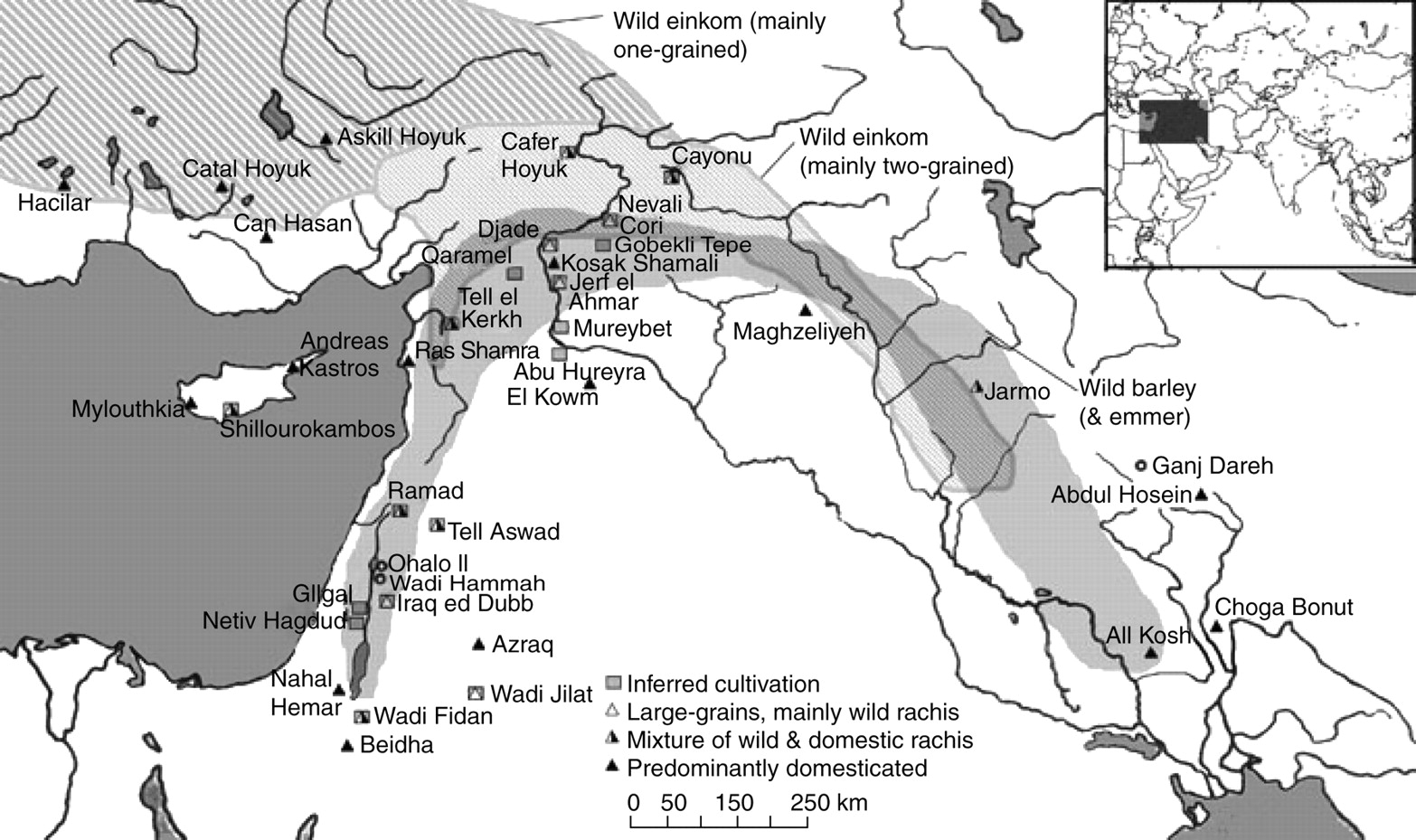
A more detailed look at where it is and an over head map of the site
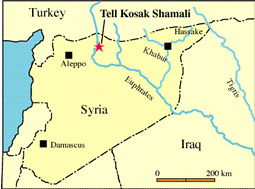
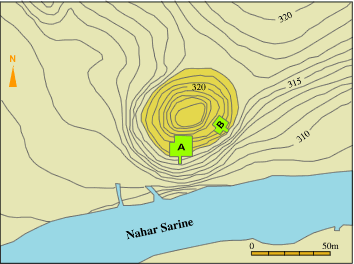
A close up of the ruins themselves

The people made pottery, a great deal of pottery

Pottery was important to these people and they probably traded it
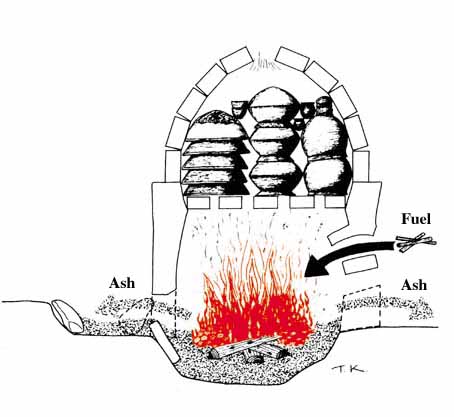
If you are a bad archaeologist you are sent to the sherd sortin' shed (I always hated that)
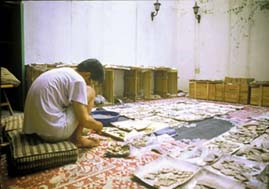
The site was burned down and this image shows some of the carbon left behind
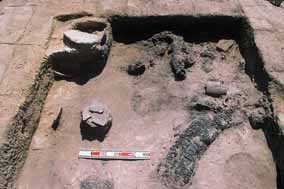
Main site link
The earlier threads take you from prior to the agricultural 'revolution', at its cusp and its results
Djade
Nevali Cori
Cayonu
Jerf el Ahmar
This is the fifth site, to be followed by three more; Mureybet, Cafer Hoyuk and Qaramel
Tell Kosak Shamali is a prehistoric site situated on the east bank of the Euphrates. It is a small mound located in the area to be submerged by construction of the Tishreen dam on the Upper Euphrates, north of the Tabqa dam. Since the early 1980s, a series of salvage archaeological operations by both Syrian and international teams has taken place in this dam flood zone producing a rich realm of information on the past human activities and their developments in this particular region of Syria. The excavations at Tell Kosak Shamali were carried out in this context by the University of Tokyo team between 1994 and 1997 with an emphasis on investigating cultural deposits of the Chalcolithic period. I was fortunte to visit this site in the summer of 1996, where I used up the 100 or so words of Japanese I knew and looked thru the site. German run site have a reputation of being orderly but this Japanese one put them to shame!
Location of this site in relation to the others

A more detailed look at where it is and an over head map of the site


The excavation of two areas revealed stratified settlements of the Neolithic to the Middle Uruk periods, dating from the 7th to the 4th milennium BC. The most important discovery was a series of pottery workshops of the Ubaid and Post-Ubaid periods. The detailed analysis of the workshops demonstrated the increasing social and economic complexity in these periods, which eventually led to the emergence of urban society in North Syria.
A close up of the ruins themselves

The main economy of the Ubaid inhabtants was based on farming. Barley and two species of wheat (emmer and einkorn) were cultivated in the large flood plain as well as in the hilly hinterland. Stock breeding of sheep and goat also made up an important part of daily life. They were mainly killed for meat when young, but notably after the late Ubaid period some females were kept for secondary products, probably milk. A small number of pigs and cattle were also raised. These domesticated food resourses were occasionally supplemented by wild animals including gazelles, water birds and fish.
The people made pottery, a great deal of pottery

The tool kits of the Ubaid people consisted of a pottery with fine painted decoration, harvesting and processing tools of grain, wood working axes, spindle whorls, awls and spatulas, and stamp seals for goods control. these tools were mostly made of locally available raw materials. the use of exotic materials, like obsidian from Anatolia, was relatively rare.
Pottery was important to these people and they probably traded it
Potter's workshops were discovered from many levels of the Ubaid period. One of the common features is that they overlapped traces of domestic activities in the same building complexes, such as ovens, infant burials and grain storage. this undifferentiated use of similar structures for different purposes may characterize the use of space in the Ubaid period, which is in clear contrast with that in later periods.
Pottery of the post-Ubaid period no longer included many painted vessels as in the Ubaid period, but most of them were simple plain wares. Firing was made with a higher temperature using the developed kilns. Pottery production tools also showed changes from the Ubaid period. Ring-shaped scrapers joined in the tool inventory, and stone palettes for pigment preparation, very common in the Ubaid period, virtually disappeared.

If you are a bad archaeologist you are sent to the sherd sortin' shed (I always hated that)

The site was burned down and this image shows some of the carbon left behind

The charcoal samples derived from building materials consisted of taxa typically encountered in the gallery forest of the Euphrates. Poplar, willow and alder were used for roof beams while tamarisk was used to cover the spaces between the beams.
Main site link
I like reading these threads.
I have a few somewhat off-topic questions if you have time to answer:
(1) I read a book by a geologist who believes that metallurgy was discovered when ores were used to decorate pottery and separated during firing. Is that the standard belief?
(2) What did people use pottery for primarily? It seems like a basket or a leather sack might be a cheaper and lighter container than a clay jar. Were they only used for storing liquids?
(3) How many pots would each person use in a year on average?
I have a few somewhat off-topic questions if you have time to answer:
(1) I read a book by a geologist who believes that metallurgy was discovered when ores were used to decorate pottery and separated during firing. Is that the standard belief?
(2) What did people use pottery for primarily? It seems like a basket or a leather sack might be a cheaper and lighter container than a clay jar. Were they only used for storing liquids?
(3) How many pots would each person use in a year on average?
Originally posted by cloudyday
(1) I read a book by a geologist who believes that metallurgy was discovered when ores were used to decorate pottery and separated during firing. Is that the standard belief?
I'm unsure of what the consensus is, I suspect there is no consensus do to the lack of any hard evidence. Some of the contenders are:
As you stated above
That rocks used around fires melted
Minerals used in cosmetic were melted in a number of way
Rocks used for kilns melted
I would suspect that raw gold and copper were first - put in the fire- to see what would happen
(2) What did people use pottery for primarily? It seems like a basket or a leather sack might be a cheaper and lighter container than a clay jar. Were they only used for storing liquids?
Cooking and storage, somewhere someplace some has probably written a thesis, paper or book on this subject. pottery made grain and water storage safe against insects-it also led to fermentation
(3) How many pots would each person use in a year on average?
Sorry don't have a clue on that one.....where is our Phd student when you need her? Byrd?
Off the top of my head - a lot, based on the coating of sherds I've seen in the Middle-East
reply to post by Hanslune
Hans, does anyone have an idea why so many of these pre-agriculture settlement sites show signs of what appears to be deliberate, effortful destruction?
This one, at least, was razed – a relatively common fate among human communities. But Djade was, we are told, filled in with mud, while Gobelki Tepe was inundated by rubble. Why?
Were they pulled down and buried by conquerors who wished to extirpate all traces of them?
Could it have been done by the former inhabitants themselves, for some bizarre (probably religious or magical) reason?
Or – here's a thought – could such destruction have been the response to an outbreak of plague? Remember, these were the earliest large settled communities, and epidemics must have been rife, novel and terrrifying.
And on a not-unrelated note, what is the earliest archaeological evidence of human warfare? (I perceive there is a problem of definition here, but I'll let you decide what we mean by 'warfare'.)
By the way, your threads are one of the reasons I keep coming back to this site.
Hans, does anyone have an idea why so many of these pre-agriculture settlement sites show signs of what appears to be deliberate, effortful destruction?
The site was burned down and this image shows some of the carbon left behind
This one, at least, was razed – a relatively common fate among human communities. But Djade was, we are told, filled in with mud, while Gobelki Tepe was inundated by rubble. Why?
Were they pulled down and buried by conquerors who wished to extirpate all traces of them?
Could it have been done by the former inhabitants themselves, for some bizarre (probably religious or magical) reason?
Or – here's a thought – could such destruction have been the response to an outbreak of plague? Remember, these were the earliest large settled communities, and epidemics must have been rife, novel and terrrifying.
And on a not-unrelated note, what is the earliest archaeological evidence of human warfare? (I perceive there is a problem of definition here, but I'll let you decide what we mean by 'warfare'.)
By the way, your threads are one of the reasons I keep coming back to this site.
edit on 5/3/12 by Astyanax because: of novelty and terror.
reply to post by Astyanax
Ah one of my favorite subjects; when did man turn to war, you can sometimes tell that by adaptations to their weapons, weapons for hunting are not specifically useful for hunting humans, especially those in a defensive situation where they cannot be shot with an arrow or speared like an animal.
Development of body armour, especially shields and helmets
You can also tell by damage to the skeletons, both by weapon hits and also the long term damage from using weapons. Stuff like
Swordsmen elbow and shoulder
Thousands of micro fractures in the left arm of a right hand man using a shield
AFAWK specialization for war began about 5,000 BC however it should be pointed out that you can use normal hunting weapons to fight men and people used those types of weapons up until the present day
Study of hunter-gathers show that about 40% of the men die in raiding situations; this may have been the fate of a number of the sites - which probably led to villages, then to walls
Ah one of my favorite subjects; when did man turn to war, you can sometimes tell that by adaptations to their weapons, weapons for hunting are not specifically useful for hunting humans, especially those in a defensive situation where they cannot be shot with an arrow or speared like an animal.
Development of body armour, especially shields and helmets
You can also tell by damage to the skeletons, both by weapon hits and also the long term damage from using weapons. Stuff like
Swordsmen elbow and shoulder
Thousands of micro fractures in the left arm of a right hand man using a shield
AFAWK specialization for war began about 5,000 BC however it should be pointed out that you can use normal hunting weapons to fight men and people used those types of weapons up until the present day
Study of hunter-gathers show that about 40% of the men die in raiding situations; this may have been the fate of a number of the sites - which probably led to villages, then to walls
Don't forget forest or grass fires..a common occurance if there is ground cover to support it
I often work in a place where the whole grounds keeping routine is based on fire prevention
Even with modern fire fighting gear the place could be lost so fast there is nothing that could be done
I often work in a place where the whole grounds keeping routine is based on fire prevention
Even with modern fire fighting gear the place could be lost so fast there is nothing that could be done
reply to post by Danbones
Very true, I saw a Danish site swept by such a grass fire. Fortunately the excavated area was clear of anything burnable and they sheltered there until the fire, having burned the tents and scorched the vehicles, past on
Very true, I saw a Danish site swept by such a grass fire. Fortunately the excavated area was clear of anything burnable and they sheltered there until the fire, having burned the tents and scorched the vehicles, past on
new topics
-
Putin, Russia and the Great Architects of the Universe
ATS Skunk Works: 2 hours ago -
A Warning to America: 25 Ways the US is Being Destroyed
New World Order: 7 hours ago
top topics
-
President BIDEN's FBI Raided Donald Trump's Florida Home for OBAMA-NORTH KOREA Documents.
Political Conspiracies: 12 hours ago, 31 flags -
A Warning to America: 25 Ways the US is Being Destroyed
New World Order: 7 hours ago, 13 flags -
Is AI Better Than the Hollywood Elite?
Movies: 14 hours ago, 4 flags -
Maestro Benedetto
Literature: 14 hours ago, 1 flags -
Putin, Russia and the Great Architects of the Universe
ATS Skunk Works: 2 hours ago, 1 flags
active topics
-
Gaza Terrorists Attack US Humanitarian Pier During Construction
Middle East Issues • 45 • : FlyersFan -
A Warning to America: 25 Ways the US is Being Destroyed
New World Order • 15 • : jidnum2 -
Chris Christie Wishes Death Upon Trump and Ramaswamy
Politicians & People • 25 • : RazorV66 -
Skinwalker Ranch and the Mystery 1.6GHz Signal
Aliens and UFOs • 145 • : Ophiuchus1 -
University of Texas Instantly Shuts Down Anti Israel Protests
Education and Media • 273 • : HerbertWest -
Krystalnacht on today's most elite Universities?
Social Issues and Civil Unrest • 6 • : FlyersFan -
Hate makes for strange bedfellows
US Political Madness • 50 • : 19Bones79 -
Weinstein's conviction overturned
Mainstream News • 28 • : burritocat -
Sunak spinning the sickness figures
Other Current Events • 25 • : Ohanka -
Cats Used as Live Bait to Train Ferocious Pitbulls in Illegal NYC Dogfighting
Social Issues and Civil Unrest • 24 • : NoviceStoic4
7
